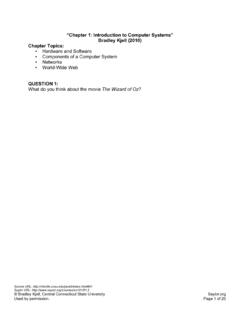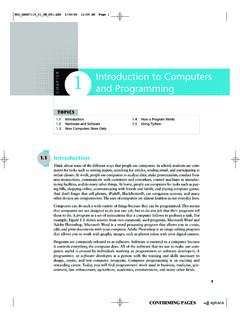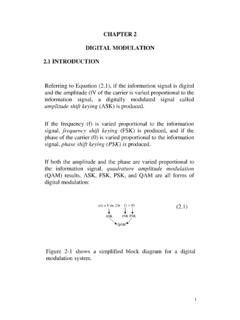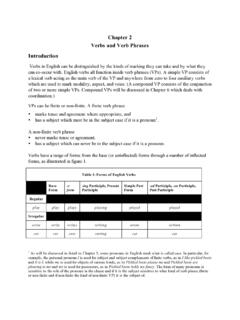Transcription of Chapter 2 Motion of Charged Particles in Fields
1 Chapter 2 Motion of Charged Particles in Fields Plasmas are complicated because motions of electrons and ions are determined by the electric and magnetic Fields but also change the Fields by the currents they carry. For now we shall ignore the second part of the problem and assume that Fields are Prescribed. Even so, calculating the Motion of a Charged particle can be quite hard. Equation of Motion : dv m = q ( E + vB ) ( ) dt charge E field velocity B field Rate of change of momentum Lorentz Force Have to solve this differential equation, to get position r and velocity (v= r ) given E(r, t), B(r, t). Approach: Start simple, gradually generalize. Uniform B field, E = 0. mv = qv B ( ) Qualitatively in the plane perpendicular to B: Accel. is perp to v so particle moves in a circle whose radius rL is such as to satisfy 2 vrL is the angular (velocity) frequency mrL 2 = m = q v B ( ) | |1st equality shows 2 = v2 L 2/r (rL = v / ) 17 Figure : Circular orbit in uniform magnetic field.
2 VHence second gives m 2 = q v B | |q B = | |. ( ) m Particle moves in a circular orbit with q B angular velocity = | |the Cyclotron Frequency ( ) m vand radius rl = the Larmor Radius. ( ) By Vector Algebra Particle Energy is constant. proof : take v. Eq. of Motion then d 1 = mv 2 = qv.(v B) = 0. ( ) dt 2 Parallel and Perpendicular motions separate. v= constant because accel ( v B) is perpendicular to B. Perpendicular Dynamics: Take B in z direction and write components mv x = qvy B , mv y = qvxB ( ) Hence qB qB 2 v x = v y = vx = 2 vx ( ) m m Solution: vx = v cos t (choose zero of time) Substitute back: mqvy = v x = |q | v sin t ( ) qB 18 Integrate: vx = x0 + sin t , y = y0 + q v cos t ( ) |q| Figure : Gyro center (x0, y0) and orbit This is the equation of a circle with center r0 = (x0, y0) and radius rL = v / : Gyro Radius.
3 [Angle is = t] Direction of rotation is as indicated opposite for opposite sign of charge: Ions rotate anticlockwise. Electrons clockwise about the magnetic field. The current carried by the plasma always is in such a direction as to reduce the magnetic field. This is the property of a magnetic material which is Diagmagnetic . When v is non zero the total Motion is along a helix. Uniform B and non zero E mv = q(E + v B) ( ) Parallel Motion : Before, when E = 0 this was v= const. Now it is clearly qE v = ( ) m Constant acceleration along the field. Perpendicular Motion Qualitatively: Speed of positive particle is greater at top than bottom so radius of curvature is greater. Result is that guiding center moves perpendicular to both E and B. It drifts across the field. Algebraically: It is clear that if we can find a constant velocity vd that satisfies E + vd B = 0 ( ) 19 Figure : E B drift orbit then the sum of this drift velocity plus the velocity d vL = [rLe i (t t0)] ( ) dt which we calculated for the E = 0 gyration will satisfy the equation of Motion .
4 Take B the above equation: 0 = E B + (vd B) B = E B + ( )B B2 vd ( ) so that vd = E B ( ) B2 does satisfy it. Hence the full solution is v = v+ vd + vL ( ) parallel cross field drift Gyration where qE v = ( ) m and vd (eq ) is the E B drift of the gyrocenter. Comments on E B drift: 1. It is independent of the properties of the drifting particle (q, m, v, whatever). 2. Hence it is in the same direction for electrons and ions. 3. Underlying physics for this is that in the frame moving at the E B drift E = 0. We have transformed away the electric field. 4. Formula given above is exact except for the fact that relativistic effects have been ignored. They would be important if vd c. 20 Drift due to Gravity or other Forces Suppose particle is subject to some other force, such as gravity.
5 Write it F so that 1 mv = F + q v B = q( F + v B) ( ) q This is just like the Electric field case except with F/q replacing E. The drift is therefore vd =1 F B ( ) q B2 In this case, if force on electrons and ions is same, they drift in opposite directions. This general formula can be used to get the drift velocity in some other cases of interest (see later). Non Uniform B Field If B lines are straight but the magnitude of B varies in space we get orbits that look quali tatively similar to the E B case: Figure : B drift orbit Curvature of orbit is greater where B is greater causing loop to be small on that side. Result is a drift perpendicular to both B and B. Notice, though, that electrons and ions go in opposite directions (unlike E B). Algebra We try to find a decomposition of the velocity as before into v = vd + vL where vd is constant.
6 We shall find that this can be done only approximately. Also we must have a simple expres sion for B. This we get by assuming that the Larmor radius is much smaller than the scale length of B variation , rL << B/| B ( ) | 21 | | in which case we can express the field approximately as the first two terms in a Taylor expression: B B0 + (r. )B ( ) Then substituting the decomposed velocity we get: dv m dt = m vL = q(v B) = q[vL B0 + vd B0 + (vL + vd) (r. )B] ( ) or 0 = vd B0 + vL (r. )B + vd (r. )B ( ) Now we shall find that vd/vL is also small, like r| B /B. Therefore the last term here is |second order but the first two are first order. So we drop the last term. Now the awkward part is that vL and rL are periodic. Substitute for r = r0 + rL so 0 = vd B0 + vL (rL. )B + vL (r0. )B ( ) i t We now average over a cyclotron period.
7 The last term isso it averages to zero: e 0 = vd B + vL (rL. )B . ( ) To perform the average use vqsin t, cos t ( ) rL = (xL, yL) = qcos t, q sin tvL = ( xL, y L) = v( ) q| |d So [vL (r. )B]x = vy y dy B ( ) d [vL (r. )B]y = vxy dy B ( ) (Taking B to be in the y direction). Then 2 2 vv cos t cos t cos t sin t = 0 ( ) = vy y 2 1 vq q| | q q| | ( ) = vxy = 2 So 2 B q 1 v vL (r. )B = ( ) q2| | Substitute in: 0 = vd B 2 B 2 q v q | | ( ) 22 and solve as before to get v B B 2 2 1 q||= q v q | | 2 2 B B ( ) vd = B2 B2 or equivalently 1 mvq 2B 2 B B ( ) vd = B2 This is called the Grad B drift . Curvature Drift When the B field lines are curved and the particle has a velocity v along the field, another drift occurs. Figure : Curvature and Centrifugal Force Take |Bconstant; radius of curvature Re.
8 | To 1st order the particle just spirals along the field. In the frame of the guiding center a force appears because the plasma is rotating about the center of curvature. This centrifugal force is Fcf Fcf = m 2 vRc pointing outward ( ) as a vector Rc2 Fcf ( ) = mv R2 c [There is also a coriolis force 2m( v) but this averages to zero over a gyroperiod.] Use the previous formula for a force 2 mvqB2 qB2 R2 c 23 1 Fcf B Rc B ( ) vd = = This is the Curvature Drift . It is often convenient to have this expressed in terms of the field gradients. So we relate Rc to B etc. as follows: Figure : Differential expression of curvature (Carets denote unit vectors) From the diagram db = b2 b1 = Rc ( ) and d = Rc ( ) So db dl = Rc Rc = Rc R2 c ( ) But (by definition) db dl = ( B. ) b ( ) So the curvature drift can be written 2 2 B ( bb.)
9 Rc Bmvmv( ) vd = R2 c = B2 qB2q Vacuum Fields Relation between B & Rc drifts The curvature and B are related because of Maxwell s equations, their relation depends on the current density j. A particular case of interest is j = 0: vacuum Fields . Figure : Local polar coordinates in a vacuum field B = 0 (static case) ( ) 24 Consider the z component 1 0 = ( B)z =(rB ) (Br = 0 by choice). ( ) r r B B = + ( ) r r or, in other words, B ( B)r = ( ) Rc [Note also 0 = ( B) = B / z : ( B)z = 0] and hence ( B)perp = B Rc/R2 .c Thus the grad B drift can be written: mv2 mV 2 Rc B ( ) v B = B B = 2qB3 2q R2B2 c and the total drift across a vacuum field becomes 1 2 1 2 vR + v B = mv + mv Rc B . ( ) q 2 R2B2 c Notice the following: 1. Rc & B drifts are in the same direction. 2. They are in opposite directions for opposite charges.
10 3. They are proportional to particle energies 4. Curvature Parallel Energy ( 2) Perpendicular Energy B 5. As a result one can very quickly calculate the average drift over a thermal distribution of Particles because 1 2 T mv = ( ) 2 2 1 2 mv = T 2 degrees of freedom ( ) 2 Therefore b2T Rc B 2T B b. ( ) vR + v B = q R2B2 = qB2 c 25 Interlude: Toroidal Confinement of Single Parti cles Since Particles can move freely along a magnetic field even if not across it, we cannot ob viously confine the Particles in a straight magnetic field. Obvious idea: bend the field lines into circles so that they have no ends. Figure : Toroidal field geometry Problem Curvature & B drifts 1 1 R B2 2 ( ) +vd = mv mv R2B22 q 1 1 12 2 ( ) += mv |vd| q mv 2 BR Ions drift up. Electrons down.














